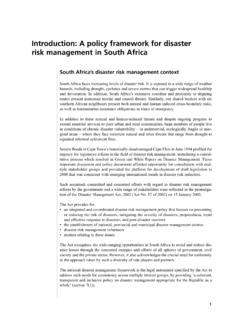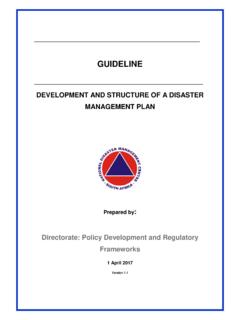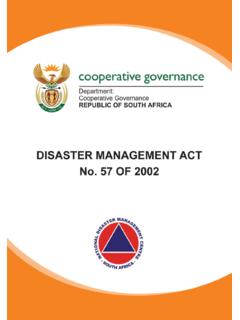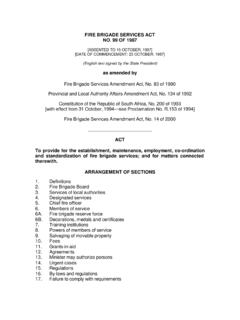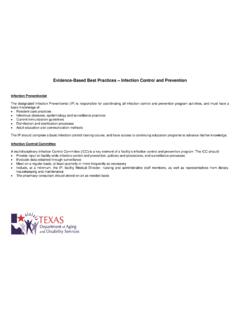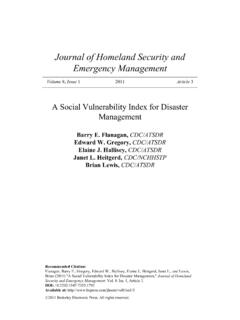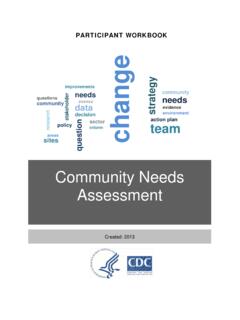Transcription of Disaster Management Monitoring and Evaluation Framework
1 Disaster Management Monitoring AND. Evaluation Framework . March 2014. Disaster Management M&E Framework March 2014 - 1. TABLE OF CONTENTS. 1. Introduction and Background .3. 2. Legislative and Policy imperatives 5. 3. Objectives and Context .8. 4. Institutional arrangements ..10. 5. Monitoring and reporting requirements ..16. 6. Assessments, Reviews and Evaluations 20. 7. Evaluations Reporting ..23. 8. Minimum Norms and Standards for Monitoring , Reporting and Evaluation .25. 9. Critical success factors 27. ANNEXURE A: M&E standards and Principles ..29. Disaster Management M&E Framework March 2014 - 2. 1. INTRODUCTION AND BACKGROUND. The international community agrees that Monitoring and Evaluation has a strategic role to play in informing policy making processes.
2 The aim is to improve relevance, efficiency and effectiveness of policy reforms. Over the last two decades, countries around the world have undertaken and implemented reforms that are aimed at improving the effectiveness and relevance of public sector Management . The importance of outcomes was reinforced by governments, driven by a political imperative to produce and to be able to demonstrate results of importance to the political leadership and to the citizenry. This resulted in many countries developing country-led Monitoring and Evaluation systems to enhance evidence-based policy making. This important development is aimed at facilitating the availability of evidence relevant to country-specific data needs to monitor policy reforms and national development goals, whilst at the same time, ensuring technical rigour through Monitoring and Evaluation capacity development.
3 However, effective country-led Monitoring and Evaluation systems will also have to address a second challenge: to bridge the gap between policy-makers (the users of evidence) and statisticians, evaluators and researchers (the providers of evidence). Monitoring and Evaluation (M&E) provides decision makers with the ability to draw on causal linkages between the choice of policy priorities, resourcing, programmes, the services actually delivered and the ultimate impact on communities. M&E. provides answers to the so what question, thus addressing the accountability concerns of stakeholders and give public sector managers information on progress toward achieving stated targets and goals. It also provides substantial evidence as the basis for any necessary corrections in policies, programmes, or projects.
4 Whilst the primary purpose of Monitoring is to determine if what is taking place is as planned, Evaluation is intended to identify the causality between intervention, a public policy and its results. The main aim is to ensure that performance is improved and the desired results are achieved, by measuring and assessing performance in order to more effectively manage the outcomes and associated outputs known as development results. The development of an effective M&E system will result in advancing the objects of a sustainable development for the country. The outcome-based approach will serve as a frame of reference to ensure that inputs, activities and outputs are appropriate. It is also a form of demonstrating the value and benefits of public services to the citizens and legislature.
5 An outcome-based approach is also an essential component of a learning approach that do not only demonstrate that outcome has occurred, but that government interventions have contributed to these positive changes in some way. It is therefore, important that the coordination of disasters in the country is fully supported by both at political and top administrative levels. The engagement and involvement of the Department of Disaster Management M&E Framework March 2014 - 3. Performance Monitoring and Evaluation in the establishment of an effective M&E. system for Disaster Management is therefore of outmost importance . Of importance to state is the cost of repairing, rehabilitation and reconstruction of damaged infrastructure after every Disaster has occurred.
6 For this reason, it is important to develop an M&E system that will link outcome information appropriately with the budget allocation process, so as to illustrate the benefits that arise from expenditure especially for post Disaster rehabilitation and Disaster risk reduction. The introduction of a Monitoring and Evaluation (M&E) system in a public institution or on a country-wide basis is a significant undertaking that generally requires both organisational changes as well as cultural changes within the public sector. For example, establishing clarity of purpose' for the M&E system, and communicating the vision' are important elements at the outset. In an effort to ensure the implementation of the Disaster Management policy and legislation and all other related matters, the NDMC has created a Monitoring and Evaluation Chief Directorate.
7 The main functions of the unit is to ensure that the country has an integrated system for Monitoring reporting and evaluating Disaster Management initiatives across the spheres of government. Government-Wide Monitoring and Evaluation System The White Paper on Local Government directs national government to provide a coherent Framework that seeks to ensure that the reporting requirements placed on municipalities are reasonable, and should also ensure the rationalisation and standardisation into an annualised national data collection system. The outcome of this process will enable government to acquire reliable information from local government on progress in the implementation of policies and programmes. In 2009, the South African government adopted an Outcome-Based Approach to track the performance and impact of service delivery to the citizens.
8 A number of policies and frameworks have been developed by the Department of Performance Monitoring and Evaluation (DPM&E) as well as National Treasury (NT) and the department of Cooperative Governance and Traditional Affairs (COGTA) to monitor the progress on service delivery across the spheres of government. The Presidency's document on Improving Government Performance, which has some of its guiding principles as: Strengthening our ability to cooperate across the three levels of government and work as a single delivery machine, Build a partnership between government and civil society so that we can work together to achieve our goal of a better life. Disaster Management M&E Framework March 2014 - 4. Further the Policy Framework for the Government-Wide Monitoring and Evaluation document, states that the aim of having a government wide system is to provide an improved integrated Monitoring an Evaluation of outcomes and impact across the whole of government.
9 Improving M&E will lead to quality of planning, implementation, reporting, decision making and policy review and development. 2. LEGISLATIVE AND POLICY MANDATES. The Management of disasters in the country is informed by the Disaster Management Act no 57 of 2002. The NDMC is established an institution within the public service and forms part of the, and functions within a department of state for which the Minister is responsible as indicated in section 8 and 9 of the Disaster Management Act, 2002. The Disaster Management Act provides for an integrated and coordinated Disaster Management policy that focuses on preventing or reducing the risk of disasters mitigating the severity of disasters, emergency preparedness, rapid and effective response to disasters and post- Disaster recovery.
10 It further provides for the establishment of national, provincial and municipal Disaster Management centres, Disaster Management volunteers and any other matters incidental thereto. The Monitoring and Evaluation Framework of Disaster and fire services Management is underpinned by the values and principles governing public administration as enshrined in the South African Constitution, Chapter 10 which includes accountability of public administration and transparency to the public fostered through provision of timely, accessible and accountable information. In addition to this, the National Development Plan 2030, in its objectives for environmental sustainability and resilience provides for an improved Disaster preparedness for extreme climate events.

